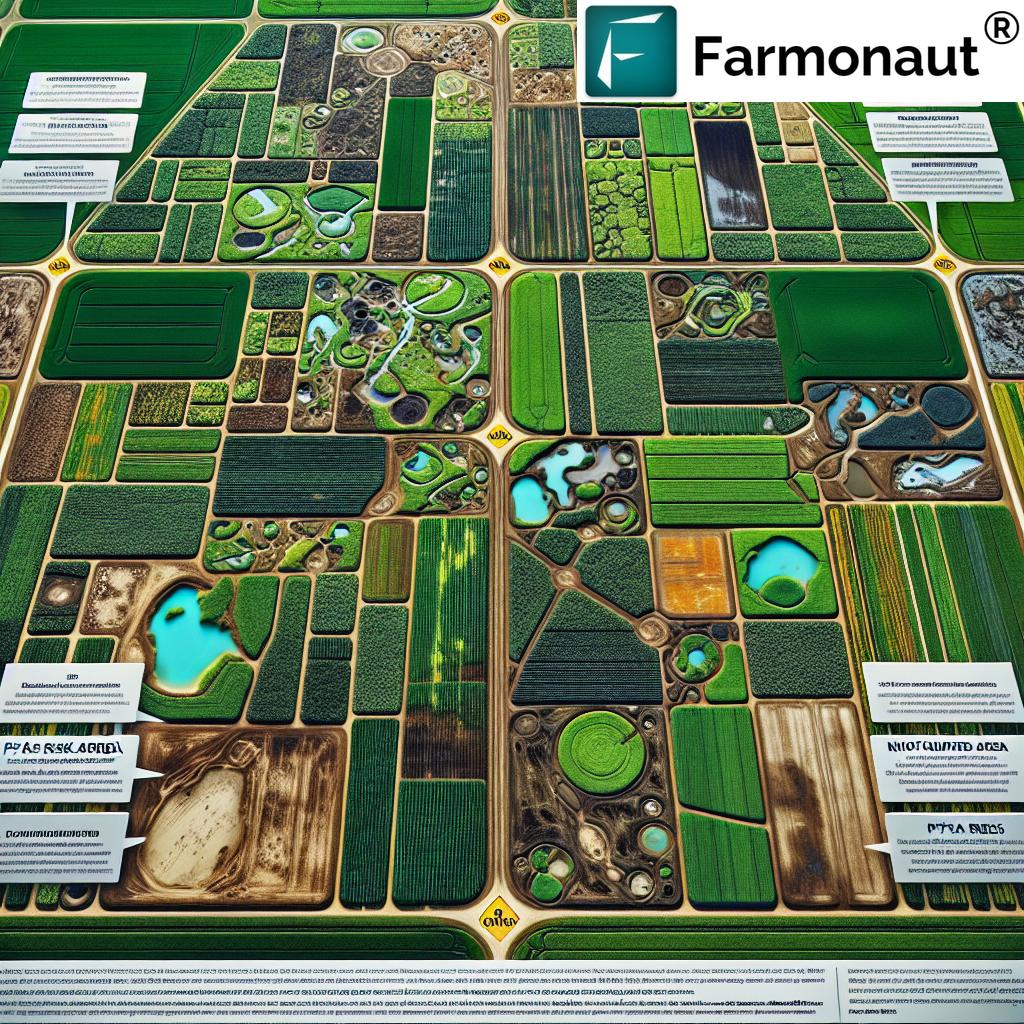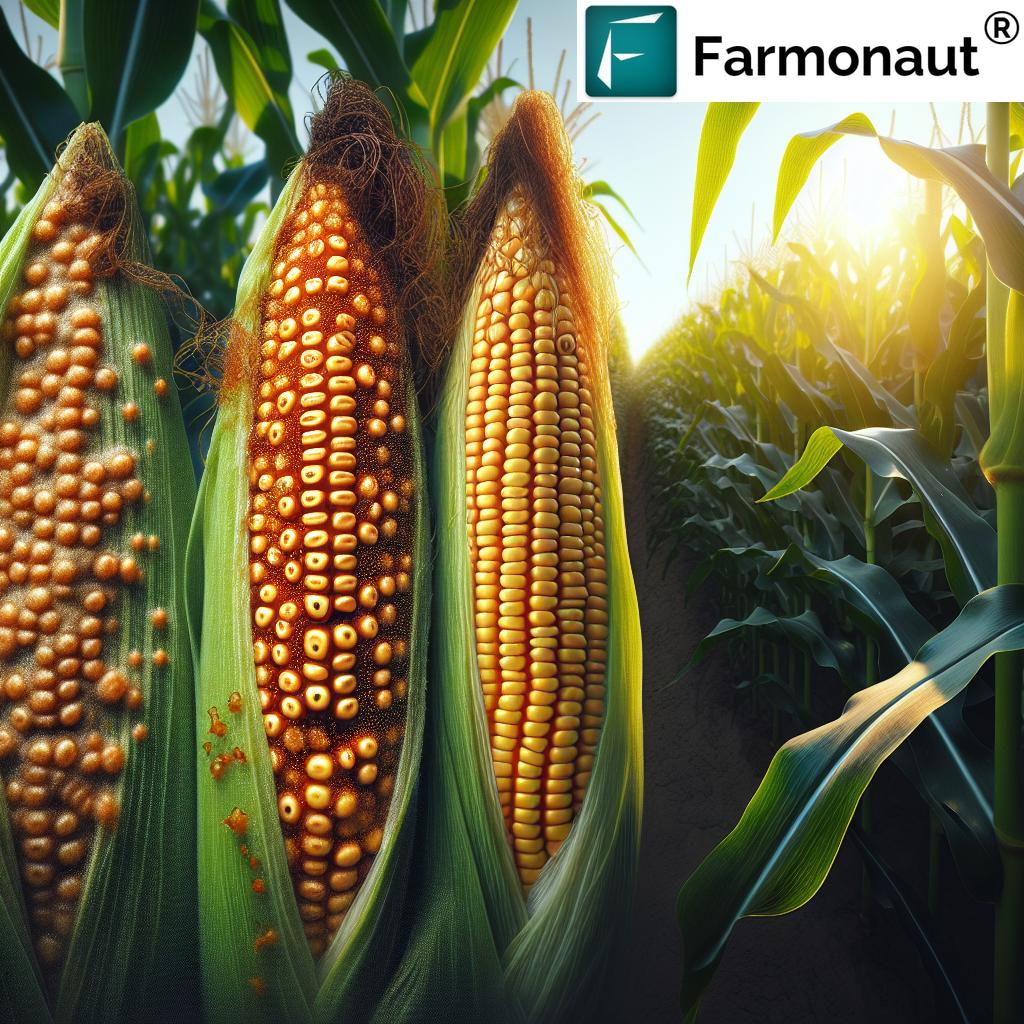Edges of Leaves Curling Up? 7 Proven Fixes Revealed!
“Up to 60% of leaf curling cases in crops are caused by pest infestations or nutrient deficiencies.”
Are the edges of your plant leaves curling up unexpectedly? This is one of the most common symptoms observed in agricultural settings such as farming, forestry, and home gardening. While seeing leaf edges turning upward might spark worry, the good news is many causes of leaf curl can be accurately diagnosed and effectively managed using proven scientific strategies—and with the right technology, such as Farmonaut’s advanced monitoring systems, we can prevent such issues before they become widespread.
In this comprehensive guide, we’ll cover why leaf curling occurs, reveal seven proven fixes backed by research and expert agronomy, and show you how to use data-driven tools—including satellite imagery and smart apps—to identify, monitor, and mitigate leaf curling in your crops. By understanding the true causes of leaf curl and implementing the proper management strategies, we can keep our plants healthy, maximize crop yield, and reduce stress across our fields or gardens.
Understanding Leaf Curling in Plants: What Are We Observing?
Leaf curling in plants is not just an aesthetic issue—it’s a visible indicator that something is wrong within our plants’ internal or external environment. When the edges of leaves start curling up or show abnormal twists, we’re seeing a physiological response to stress, damage, or disruption. This curling symptom often appears alongside other signals such as discoloration, leaf cupping, necrotic spots, or stunted growth. Whether in our crops, vegetables, forestry plantations, or home gardens, these signs demand careful attention and timely action.
- Visual Cue: The edges of leaves curling upward can happen on new, middle-aged, or older leaves, sometimes only affecting specific areas or the entire plant.
- Commonality: It’s a phenomenon observed in a wide range of agricultural settings—from tomato farms in India to strawberry greenhouses in Europe to papaya orchards across the tropics.
- Underlying warning: The real concern is often what’s causing the leaf curl: pests, diseases, nutrient deficiencies, environmental stress, and more can all lead to similar symptoms but require different remedies.
By identifying the root causes of leaf curling, we can apply targeted management strategies and ensure our agricultural ventures remain productive and sustainable.
7 Key Causes of Leaf Curling: Comprehensive Guide
Let’s examine the seven most prominent reasons behind leaf curling in plants, with detailed explanations and focus on how to spot each issue in your crops. Understanding these factors will help us decide on the most relevant fixes and management measures.
Focus keywords covered: leaf curling in plants, causes of leaf curl, management of leaf curling, pest-induced leaf curling, nutrient deficiencies and leaf curl, herbicide damage symptoms, viral leaf curl diseases, integrated pest management for leaf curl, environmental stress and leaf curling, tomato leaf curl management.
1. Environmental Stress and Leaf Curling
Environmental stressors are among the most frequent drivers of leaf curling. This typically results from high temperatures, drought conditions, poor soil moisture, or rapid vegetative growth. Many crops, especially tomatoes, beans, and beets, demonstrate upward leaf curl as a defense mechanism—helping to limit water loss and reduce exposure to harsh sun (Missouri IPM).
- Symptoms: Leaves curl chiefly at the edges, retain normal color, and the issue is often temporary.
- Impact: Usually does not significantly impact yield—unless environmental stress persists.
- Management: Proper irrigation, mulching to conserve moisture, and shade provision in high heat can help.
- Science-based tip: Monitor weather trends and soil moisture zones using Farmonaut’s satellite crop health monitoring to stay ahead of environmental triggers.
2. Pest-Induced Leaf Curling: Aphids, Whiteflies, Thrips
Many pest infestations can trigger sudden curling at the edges of leaves. Aphids and whiteflies are two of the most notorious: they feed on plant sap, distorting leaf tissues and disrupting growth regulation. Thrips can also puncture leaves and grind up juices, resulting in twisted, curled, or rolled leaves (UMD Extension).
- Symptoms: Curled, stunted, or misshapen leaves; visible presence of tiny pests on undersides; sometimes sticky residue (honeydew).
- Impact: Pest-induced leaf curling directly affects yield and can introduce viral infections.
- Management: Vigilant monitoring, early detection, and use of integrated pest management for leaf curl are essential. Biological controls (natural predators), selective insecticides, and strong cultural practices are all part of a comprehensive approach.
- Extra: Farmonaut’s NDVI crop monitoring can highlight unusual vegetative patterns, helping us pinpoint local pest incidence quickly.
3. Nutrient Deficiencies and Leaf Curl
Nutrient deficiencies are a major cause of leaf curling in plants. Calcium deficiency leads to improper expansion of leaf tips in crops like strawberries, resulting in leaves that curl upward with necrotic (dead) tips. Boron deficiency causes asymmetrical curling and fails to support healthy cell division (Cornell Berry Tool).
- Symptoms: Upward-curling leaf edges, brown/blackened or necrotic tips, possible stunted growth, or color change (e.g., yellowing).
- Impact: Can substantially reduce crop vitality and yield if uncorrected.
- Management: Soil testing and targeted fertilization based on identified deficiencies. Avoid over-fertilization to prevent burn or secondary symptoms.
- Technology benefit: By monitoring soil status over time using Farmonaut’s precision tools, we can identify at-risk zones and calibrate inputs accordingly, reducing the risk of nutrient-related leaf curl.
4. Herbicide Damage Symptoms: Drift and Leaf Curl
Herbicide exposure—especially from drift of potent chemicals like dicamba or 2,4-D—often leads to abnormal leaf curling, cupping, or downward bending in sensitive plants. Even indirect exposure (drift from a neighboring site) can cause distorted, puckered, and twisted leaves, with symptoms emerging within days (South Dakota State Extension).
- Symptoms: Leaves curl downwards or upwards, may pucker, develop odd color patterns, and have brittle or thickened surfaces.
- Impact: No effective cure after damage—leaf curl may persist for the season, and severe cases impact plant health and yield.
- Management: Prevention is key—never spray herbicides in windy conditions, establish buffer zones, and always follow label guidance.
Note: Recovery is limited; future protection is our best defense.
5. Viral Leaf Curl Diseases in Crops
Viral infections, such as Tomato Yellow Leaf Curl Virus (TYLCV) or Papaya Leaf Curl Virus (PaLCuV), are among the most damaging causes of curl in agriculture (UNL BYF, Wikipedia). | Spread by whiteflies, these viruses cause rapid upward curling, yellowing, thickened veins, and severe stunting in tomatoes and papayas.
- Symptoms: Upward-curling leaves with yellow blotches, thick veins, reduced internode length, and sometimes complete plant stunting.
- Impact: Viral leaf curl diseases can spread rapidly, decimate plant populations, and destroy entire crops if not managed.
- Management: Remove infected plants immediately, control whitefly/aphid populations using integrated pest management, choose resistant plant varieties, and disinfect tools regularly.
6. Soil Problems and Water Imbalances
Stress in soil conditions, such as poor drainage, root compaction, or salt buildup, can cause edges of leaves curling upward or even downward, depending on the severity and direction of imbalance. Underwatering can trigger drought-stress curling, while overwatering may choke roots and lead to similar symptoms from oxygen deprivation.
- Symptoms: Edges of leaves curl, entire plant appears wilted, and may drop leaves prematurely.
- Impact: Chronic soil and water-related stress reduces plant vigor, especially in sensitive vegetable crops.
- Management: Adopt smart irrigation (large scale farm management) tools and regularly monitor soil structure and drainage.
7. Genetic and Growth-Related Leaf Curl
Some plants may exhibit natural leaf curl due to genetics or rapid, uneven growth—especially in certain plant varieties of tomatoes, beans, and ornamentals. If other signs of stress, pest, or deficiency are absent, and the plant continues to grow well and flower, this curling is likely harmless.
- Symptoms: Consistent leaf curl across the plant but no other distress signals, and healthy yield.
- Management: No action required—consider it a quirk of that plant variety.
“Implementing targeted fixes can reduce leaf curling by over 40%, leading to visibly healthier plants.”
Issue vs. Solution: Leaf Curling Causes and Proven Fixes
For clarity and quick reference, here’s a side-by-side table comparing the common causes of leaf curl with expert-backed fixes and their likely improvement rates:
| Cause | Description & Symptoms | Proven Fix/Management Strategy | Estimated Improvement Rate* |
|---|---|---|---|
| Environmental Stress | Upward curling edges, often in hot/dry spells | Optimize irrigation; apply mulch; shade in extreme heat; monitor soil moisture | ~70% |
| Pest Infestation (Aphids, Whiteflies, Thrips) |
Misshapen or curled leaves; visible pests/honeydew | Integrated pest management, biological controls, targeted pesticide application | ~75% |
| Nutrient Deficiency (Calcium, Boron) | Upward-curling tips, necrotic edges, slow growth | Soil testing; apply needed nutrients; monitor fertilization rates | ~80% |
| Herbicide Exposure | Cupped or curled leaves, odd coloration post-spray (drift) | Prevent spray drift; follow herbicide best practices; avoid application during wind | ~50% (prevention), damage is permanent per season |
| Viral Infections (TYLCV, PaLCuV) |
Upward curling, yellowing, thick veins, stunted plants | Remove infected plants; control whiteflies; plant resistant varieties; disinfect tools | ~60-75% |
| Water/Soil Imbalance | Edges curl, plant wilts/drops leaves, uneven growth | Smart irrigation; check drainage; improve soil structure | ~70-80% |
| Genetic/Physiological | Uniform curl, no distress, healthy growth otherwise | No action needed | 100% (no impact) |
*Improvement rates are broad estimates based on agronomy research; actual results may vary depending on local conditions and promptness of intervention.
Management of Leaf Curling: 7 Proven Fixes for Healthier Plants
The most effective management of leaf curling involves an integrated approach—targeting the right cause with the right solution. Here are the seven most impactful strategies, each tailored to the corresponding cause:
-
Regular Monitoring and Early Detection
- Inspect plants routinely for any symptom of leaf curling, pest signs, or abnormal growth.
- Early detection via traditional scouting or real-time satellite monitoring (Farmonaut App) enables proactive action—stopping spread before it escalates.
-
Adopt Smart Cultural Practices
- Ensure balanced watering—avoid both drought (underwatering) and excessively wet (overwatering) conditions.
- Use mulching and contour planting to reduce water stress; keep soil pH at crop-optimal levels.
- Select site-appropriate, disease/pest-resistant crop varieties for local fields/greenhouses.
-
Integrated Pest Management for Leaf Curl
- Combine cultural, biological, and chemical pest control for maximum impact.
- Introduce predatory insects (e.g. ladybugs for aphids)
- Apply targeted and eco-friendly pesticides, only as needed and per crop/label recommendation.
-
Address Nutrient Deficiencies and Leaf Curl
- Conduct laboratory soil tests before planting and during the season.
- Match fertilizer blend to identified deficiencies (calcium, boron, nitrogen, etc.) and crop stage.
- Don’t over-fertilize—too much nutrient can burn roots and cause new curling symptoms.
-
Best Practices in Herbicide Application
- Only apply herbicides when conditions are calm—no wind, low drift risk.
- Follow label dosage and safety protocols; create buffer zones near sensitive crops.
- Monitor for off-target damage and halt spraying at first sign of issue.
-
Disease Management: Respond to Viral Leaf Curl Diseases
- Uproot and destroy infected plants to halt the spread of viral and fungal pathogens.
- Sanitize tools, boots, and gloves between rows/areas to limit cross-infection.
- Emphasize genetically resistant varieties, especially for common viral threats like Tomato Yellow Leaf Curl Virus (TYLCV).
-
Continuous Learning and Data-Driven Management
- Leverage advances like Farmonaut’s AI-based advisory system—get crop-specific insights, pest/disease alerts, and weather forecasts directly to your device.
- Utilize resource platforms and mobile/web apps to stay informed about best practices and local disease outbreaks.
Practical Tools to Strengthen Your Approach:
- Farmonaut Satellite Monitoring: Detect early warning signs (vegetative stress, irregular soil moisture, pest pattern breaks) across broad areas. Start monitoring your crops today.
- Farmonaut Fleet Management: Ensure timely and efficient spraying, irrigation, and harvest operations. Great for large-scale and coordinated farm management.
- Resource Planning, Carbon Footprinting: Optimize fertilization and irrigation scheduling to minimize inputs, maximize appeal to eco-markets, and track your farm’s carbon footprint.
- Product Traceability: Use Farmonaut’s blockchain-based traceability to boost consumer trust by showing end-to-end crop and input history.
- APIs for Custom Workflows: Integrate crop health/watchdog analytics into your own dashboards using Farmonaut’s API and developer documentation.
How Farmonaut Empowers Precise Management of Leaf Curling in Plants
Modern plant stress management is now data-driven. Here’s how Farmonaut’s affordable satellite imagery, AI-based analytics, and real-time platforms offer powerful support in stopping leaf curling at its source:
-
Satellite-Based Crop Health Monitoring: Instantly survey crop fields and plantations for signs of stress, poor vigor, or pest infestation.
Satellite vegetation indices (like NDVI) reveal even subtle changes linked to leaf curling long before they’re visible on the ground. -
AI Advisory and Custom Notifications: Leverage AI-driven insights that analyze environmental, soil, and plant data to guide evidence-based strategies (water, nutrients, pest, and disease control).
Receive location-specific alerts when conditions favor leaf curl risks—enabling earlier interventions for better outcomes. -
Carbon Footprinting and Resource Optimization: Make irrigation and feeding more precise, reducing water and fertilizer costs—while shrinking your crop’s environmental impact.
Achieve optimal resource use while keeping plants robust and disease-resistant. - Blockchain Traceability: Prove your crops have been ethically managed, chemical-safe, and grown sustainably—adding value and trust for discerning buyers.
Start Your Journey to Digital Leaf Curl & Crop Health Management
- Web/Browsers: Farmonaut Web App
- API Access: Farmonaut Developer API | API Docs
- Android: Farmonaut on Google Play
- iOS: Farmonaut on App Store
Discover Farmonaut Subscription Plans
Explore suitable subscription options—whether you’re a smallholder, cooperative, or agribusiness. Find the tier that matches your monitoring needs, with real-time updates and advanced analytics right at your fingertips.
Frequently Asked Questions about Leaf Curling in Plants
What is the main cause of leaf edges curling upward in crops?
The main causes of leaf curl include pest attacks (notably aphids and whiteflies), environmental stresses like high heat or drought, and nutrient imbalances in the soil. Understanding these factors and responding early is critical.
Can leaf curl in tomatoes be reversed?
When caused by temporary environmental factors (heat, drought), curling can reverse with improved care. However, damage from herbicide drift or viral infections is usually permanent—managing new growth is the best strategy.
How do I quickly diagnose if pests are to blame?
Examine undersides of curled leaves for aphids, whiteflies, or thrips. Look for sticky sap and follow pest trails across stems. Early pest monitoring with the Farmonaut platform or visual scouting enhances diagnosis accuracy.
Is there a digital tool for detecting early crop stress linked to leaf curling?
Absolutely! Farmonaut’s remote monitoring platform captures field-wide imagery, detects early vegetative abnormalities, and alerts you to stress that may lead to leaf curl—enabling action well before symptoms progress.
Are all cases of leaf curl in plants harmful to yield?
Not always. Mild or genetically programmed leaf curling may have no effect. However, if symptoms persist, worsen, or impact flowering/fruit set, intervention is recommended.
Conclusion: Secure Healthier Crops by Tackling Leaf Curling at the Roots
The edges of leaves curling up present a window into our crops’ overall health—serving as early warnings of underlying stresses, pest infestations, or nutrient imbalances. By promptly identifying the cause, and using modern management and monitoring strategies, we can mitigate leaf curl symptoms and restore plant vitality.
Whether you’re managing large horticultural enterprises, kitchen gardens, forestry plots, or research fields, Farmonaut provides the tools needed for real-time diagnosis, integrated crop health management, and sustainable agriculture—available to every farmer and professional worldwide via mobile, web, and accessible APIs.
Ready to digitally transform your approach to leaf curling in plants? Download Farmonaut today on Web, Android, or iOS to begin your journey toward healthier, more resilient crops—any time, anywhere.
For advanced traceability, sustainable certification, loan/insurance verification, and carbon footprint tracking, trust Farmonaut to deliver precision, transparency, and empowerment for the next generation of agriculture.
Note: Farmonaut is not a marketplace for agricultural inputs, a manufacturer, or a farm machinery distributor—it is a leading provider of digital, satellite-supported crop management, monitoring, and advisory solutions.


















